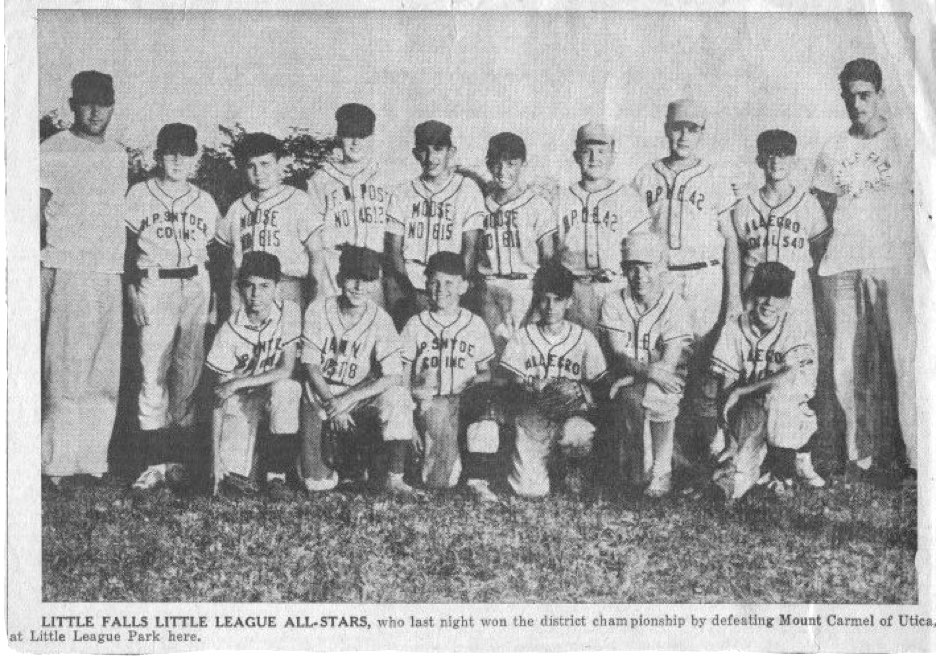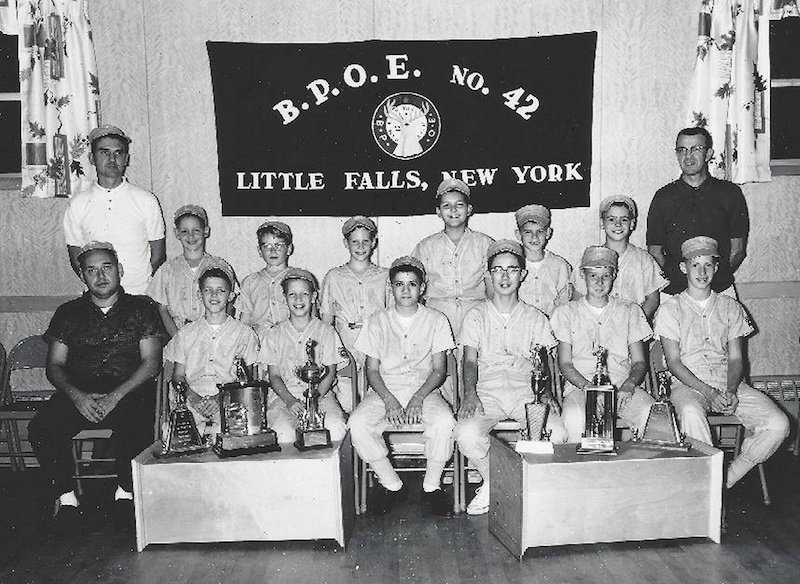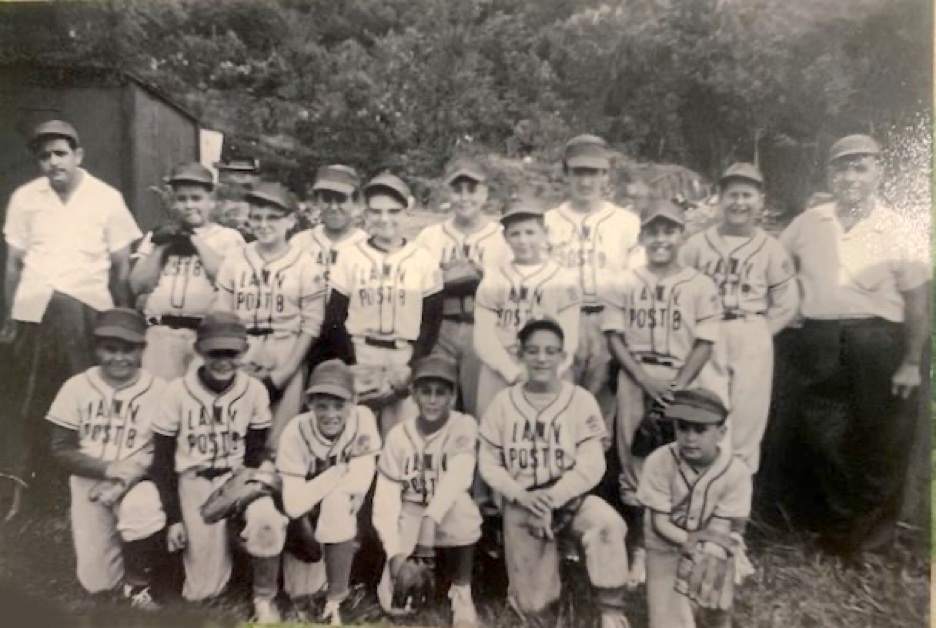Happy 70th Birthday to Little League in Little Falls
In the Beginning
Little Falls has always been a great baseball town, and much of this culture has been inculcated into our youth through the Little League program. This year marks the 70th birthday of Little League baseball in Little Falls, a milestone worthy of recognition for all of the officers, coaches, umpires, players, volunteers and parents who have contributed in any way to the success of the program. A number of excellent ballplayers, too numerous to mention, learned the rudiments of the game on the Little League fields in this city.
Yes, I said “fields” in the previous paragraph. That wasn’t a typo. The late Francis Skinner and Sam Mucica were instrumental in starting the program here. Getting the program on its feet was no small task. As there are now, there were three leagues that first year, but they were named differently:
- Grasshopper League – eventually Minor League – for 4th graders;
- Little League – for 5th and 6th graders;
- Major League – eventually Babe Ruth League – for junior and senior high school students.
The six teams in the initial year of Little League, the White Sox, Blue Sox, Shamrocks, Tigers, Bulldogs and Wildcats, all had captains. A field area had to found and groomed for the Minor and Little League players. Volunteers were needed for coaches, sponsors to provide uniforms, volunteers to help maintain the field, finding umpires, organizing a schedule of games, holding a draft for the selection of players, allotting practice times for the teams, soliciting funds, and the list goes on and on!
Games that first year were played on the South Side at a site known as Hansen’s Field. The field was approximately where Filipski’s Lumber Yard is today. Spectators brought blankets or folding chairs and sat on a grassy incline past the left field fence, near the old West Shore railroad tracks. Remember, there was no Rt. 167 arterial in those days. Budding talents like Bill and Chuck McEvoy, Tom Finnegan, Joe Cotter, Walt Oleczek, Mike Skinner, Bob Cinquanta, and Gary Irving, among others, all got their start in organized baseball when Little League began 70 years ago. This was the beginning of an era where new players had to have talent; coaches had the unenviable task of “cutting” boys from the team before the season began.
The late John Finnegan became involved in 1953 and the local league applied for a charter from Little League International that year. During these nascent years, some teams were switching names, taking the names of teams in the Eastern League, while a few teams bore the names of their sponsors, such as the VFW, Halls Motors and Holy Name (Society).
The big rivalry during the 1953 through 1955 seasons was between the VFW, coached by Pete Adamko, and the Orioles team, coached by Mario Checci and assisted by Orlando Diodati. By that time, some players from the Grasshopper League had moved up to the Little League, including players such as Dan Mosny, Bobby Glazier, Doug Ackerman, and Ray Lenarcic, who eventually went on to pitch at Fredonia State, become a professor at Herkimer County Community College, and help countless others with his altruistic work throughout the years.
Metamorphosis
By 1956, both Minor League and Little League moved to brand new facilities between the high school field and the city dump on Burwell St. Those of us who are old enough to remember can recall with pride what an improvement the new facilities were, while younger people would be appalled by the conditions. This is long before the Little Falls Mets or any other organized professional baseball came to town, and the fields were nowhere near the pristine condition they’re in today. Scoreboards were operated manually, what bleachers existed gave you splinters, and there were no tennis courts or “facilities” for taking care of your basic needs. Saving the “best” for last: putting the Little League field right next to the city dump always posed one problem or another. The city burned its trash, and so there were occasions when a pallid and odiferous cloud of smoke hung over the fields when the wind shifted in that direction. Even without the smoke, the smell of fresh garbage was ever-present. And then there were the dump rats. I never heard of them coming around during a game, but going to the dump with your .22 caliber rifle to shoot the rats was considered a sport, and was never discouraged by the local police.
Also by 1956, all teams were known by their sponsors’ names. The Elks and VFW continued to sponsor teams, while the Orioles were now sponsored by the Moose Club and the Holy Name team was now sponsored by the DeCarlo-Staffo Post. Sponsors were now, in alphabetical order, Allegro, DeCarlo-Staffo, Elks, Moose, Snyder’s, and VFW. The Grasshopper League was now known as Minor League, and the development of the players in both Minor League and Little League was beginning to bear fruit; Little Falls had previously produced a number of fine ballplayers, but organized baseball was now providing the necessary development that eventually paid off in 1959 and again in 1976. Although the Elks team was beginning its dominance in the league, competition was extremely stiff. The DeCarlo-Staffo team was tough to beat, and the others weren’t far behind.
1959
The opportunity for the youth of Little Falls to hone their baseball skills came to fruition in the summer of 1959 when the Little Falls Little League All-Star team won the District championship. The Rock City team was coached by the late Mike Izzo and Louie Pohleven, and didn’t have any major league talent, although Dennis Allmendinger was signed by the St. Louis Cardinals and played in the minor leagues. However, the team was well-rounded with very good players at every position. A quote from the Little Falls Evening Times about the team read: “On its triumphant march to the district crown, Little Falls bowled over Herkimer, Holland Patent, Dolgeville, New Hartford and then recorded an 8-3 victory over Utica Mt. Carmel to win the District 10 Championship, winning each game by a decisive margin, before finally losing 3-2 to Sherrill. [Tony] Ciletti was Little Falls’ outstanding player with 5 all-star home runs, along with 3 pitching victories. [Mike] Murray had 2 pitching victories and 2 home runs. Others key contributors were Eddie Cotter and Dick Andrews.” Andrews went on to enjoy a career as a teacher and varsity basketball coach at Little Falls High School. Rick Johnson, representing Snyder’s, also went on to become a teacher at LFHS. Roger Klimek, who played for the VFW team, became a valued educator in the Rochester area. Don Staffo went on to earn his Ph.D degree, became a nationally acclaimed educator and author, and has won numerous awards.

Kneeling (l to r): John Grau, Don Staffo, Rick Johnson, Tony Paparella, Ed Cotter, Dennis Allmendinger.
Standing: Ass’t. Coach Lou Pohleven, Dick Monahan, Tom Baum, Roger Klimek, Tony Ciletti, Fred Herringshaw. Mike Murray, Dick Andrews, Ed Vallecorsa, Coach Mike Izzo.
The late Ed Cotter and Dennis Allmendinger were both distinguished Vietnam veterans. All of these young athletes went on to become outstanding citizens, and the late Mike Izzo became mayor of Little Falls.
Coached by the late Ted Wind and Fran Murray, the Elks team continued with their winning ways in 1959. During my first year in 1959, I was privileged to play with the team that included all-stars Dick Andrews, Eddie Cotter, and Mike Murray. Tragedy struck my first year when our coach, Fran Murray (Mike’s father) passed away mid-season of a heart attack at the age of 47. The Little League team was asked to act as honorary pall bearers, and at that age, I had no experience with death or funerals. We lost a good man, way too young. The team went on to win the league championship that year, led by our all-stars. I was very fortunate to have played on the teams that I did. We won the league championship three out of the four years that I played, with little help from me. The first two years I was relegated to the mandatory two innings in right field where I could do the least amount of harm.
The Early 1960’s
The Elks won the championship again in 1960, led by players Bob Aniol, who later distinguished himself with his service in Vietnam, the late Jim Kopanski, who went on to become a golf pro, John Cotter, who went into a career in education in the Dolgeville school system, Salvi Ferraro, who went on to successful careers in the Rochester area with Eastman Kodak and Johnson & Johnson, and Andy Kaye, who moved to California for a thriving career with Swiss Reinsurance.
The DeCarlo-Staffo team, coached by the late Louis Gamberdella, won the championship in 1961. The team was led by the late Bob “Moe” Healey, Bob “Bert” Gamberdella and also included a young Bob Casullo, who went on to fame coaching for various college and professional football teams.
In 1962, the Elks reclaimed the championship. Coached by the late Bob Murphy and John Speer, the team was lead by all-stars Tony DeLuca, who since has been doing an awesome job leading the Little Falls Youth & Family Center, Al Knapp, who at one time became the winningest basketball coach in Section III history, the late Billy Burrows, who led the league in home runs that year and went on to become President/CEO of Burrows Paper and Herkimer County Trust Co. and myself.

Seated (l to r): Coach Bob Murphy, Bob Kaye, Dave Stack, Tony DeLuca, Al Knapp, John Frazier, Billy Burrows.
Standing: Coach John Speer, Paul Sadlon, Bob Tucker, Bill Mueller, Frank Sciortino, George Willman, John Willman, Ass’t. Coach Harold Knapp.
Al Knapp and I had identical 7-1 records on the mound, and Al had a phenomenal .714 batting average.
Moe
Bob “Moe” Healey was a man among boys. Moe was bigger, stronger, and faster than the rest of us, yet he was quiet, kind and considerate. Although he was a much better athlete than the rest of us, to us he was just “one of the guys.” To exemplify Moe’s athletic prowess, let’s fast-forward five years. Even though he weighed about 210 lbs., Moe was only a half-step behind Gino Orsini doing 100-yard sprints in football practice. Gino was the first string All-Iroquois League halfback, and also the fastest man in the league running the 100-yard dash in track. To the best of my knowledge, Moe was the only football player from Little Falls that Syracuse University ever showed any interest in recruiting.

Bob Healey, standing 3rd from the right, was as tall as his coaches in Little League.
Back to Little League. When I reached out to my contemporaries and asked if they had any memories of Little League, they unanimously mentioned Moe, among other things. He was that predominant a force. Nobody, but nobody, wanted to face Bob when he was on the mound. His size and strength were no match for mere mortals, and most boys were quivering before they even stepped into the batter’s box.
As for his hitting, this anecdote by Dick Laubenstein describes it best:
“I vividly remember pitching against Bob Healey in a game between VFW and DeCarlo-Staffo. My coach told me to walk Bob since he was a home run machine and as we all know a powerful young man.
The first three pitches were outside the plate and he made no attempt to swing. Naturally I thought he was going to accept the walk. My fourth pitch was again heading to the outside of the plate. He reached across the plate swung with a flick of his wrists and knocked the ball out of the park. A man of few words, he just smiled at me as he rounded the bases. A wonderful person with so much athletic talent.”
Moe’s character defined him as much as his athletic ability did. As I previously mentioned, players could be “cut” prior to the season, a situation painful to everyone involved, especially in a small city like Little Falls. I think this story best describes Bob’s moral fiber, written by someone who I choose to keep anonymous:
“When I was first eligible to play Little League (10 years old) I was drafted by DeCarlo- Staffo. I remember that the try outs were at the field on Southern Ave.
After going through all the drills on a Saturday morning I was told that I didn’t make the team and had to go back to the minor league for the season. I was heartbroken but Bob came over and told me that if I practiced hard I would make the team next year.
I will never forget walking all the way home with my “Billy Martin” baseball mitt crying.
The next year I made the DeCarlo team and played 3rd base most of the season with the exception of the several games I caught for Bob. I had to have a sponge in the catcher’s mitt since he must have been throwing 90 mph.
Thinking back on that day, I’m amazed that Bob had that much concern for a teammate.”
As a young man of 10 or 11 years old, Moe showed compassion and empathy that very few of us would for a fellow human being. These qualities remained with him throughout his life.
Bob passed away almost 25 years ago, in January of 1998. We still speak of him reverently, and miss him to this day.
John Frazier is a member of the Little Falls Historical Society. He would like to thank each and every person who contributed to this article. My sincere appreciation to you all who helped make this article possible.



